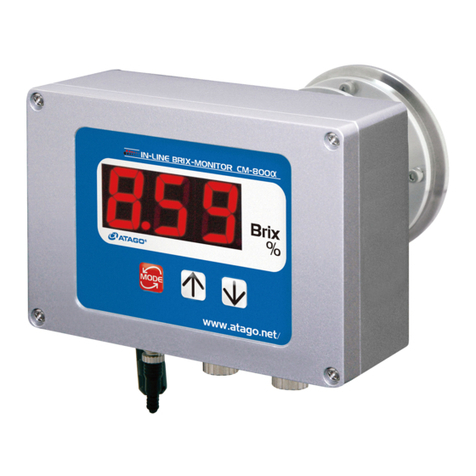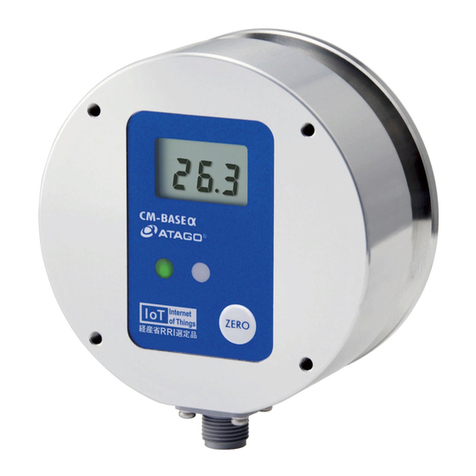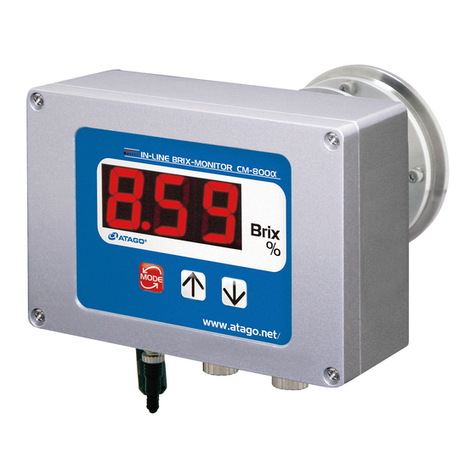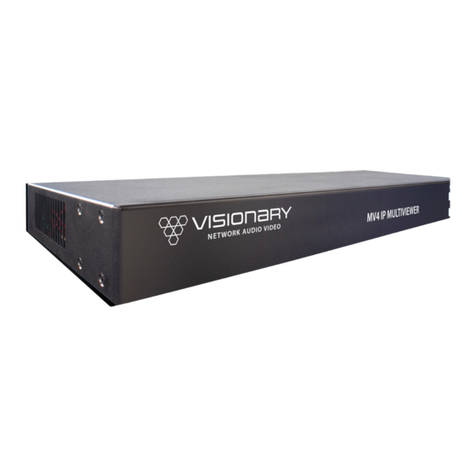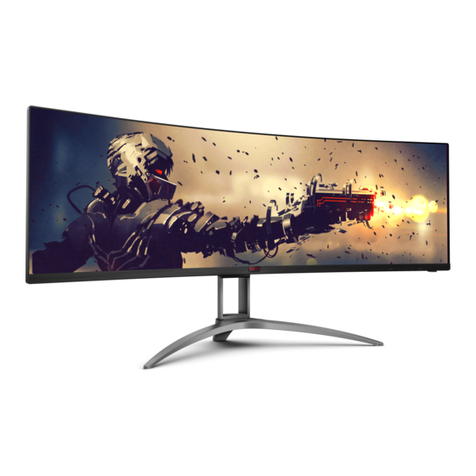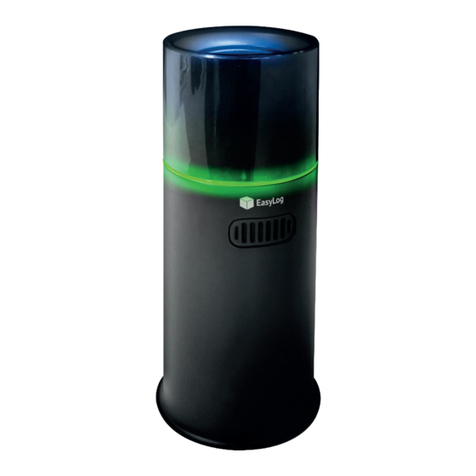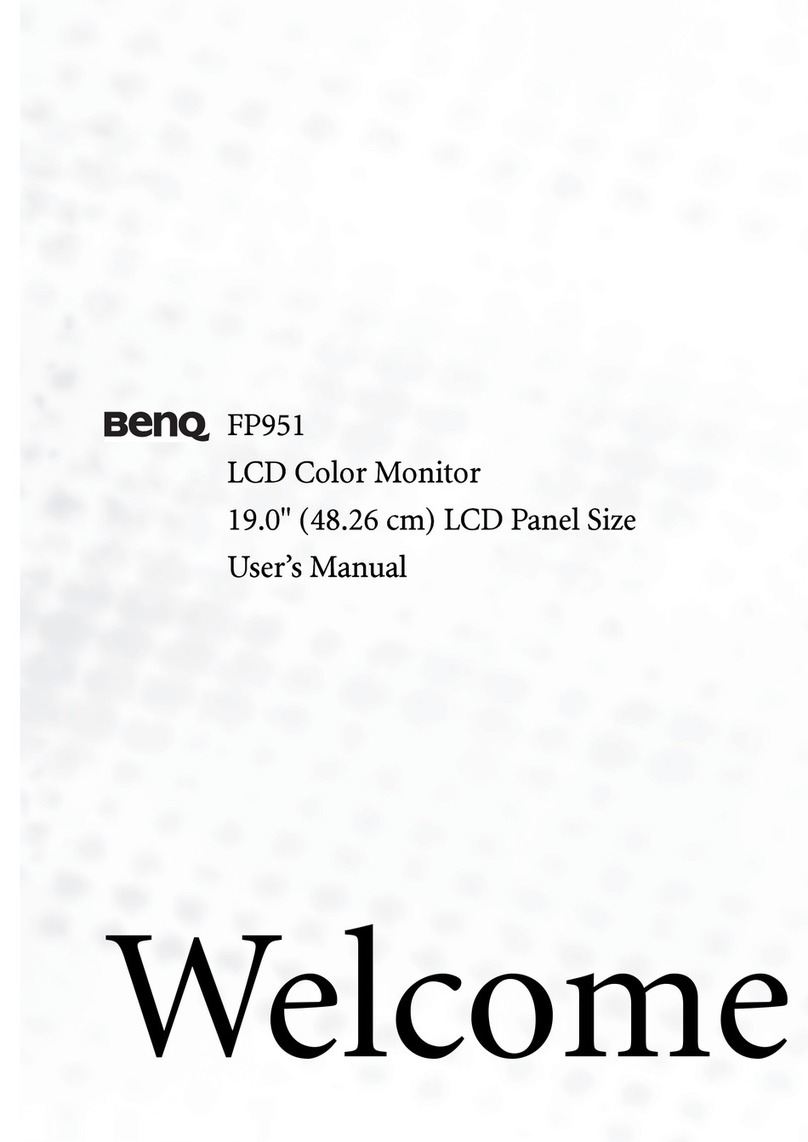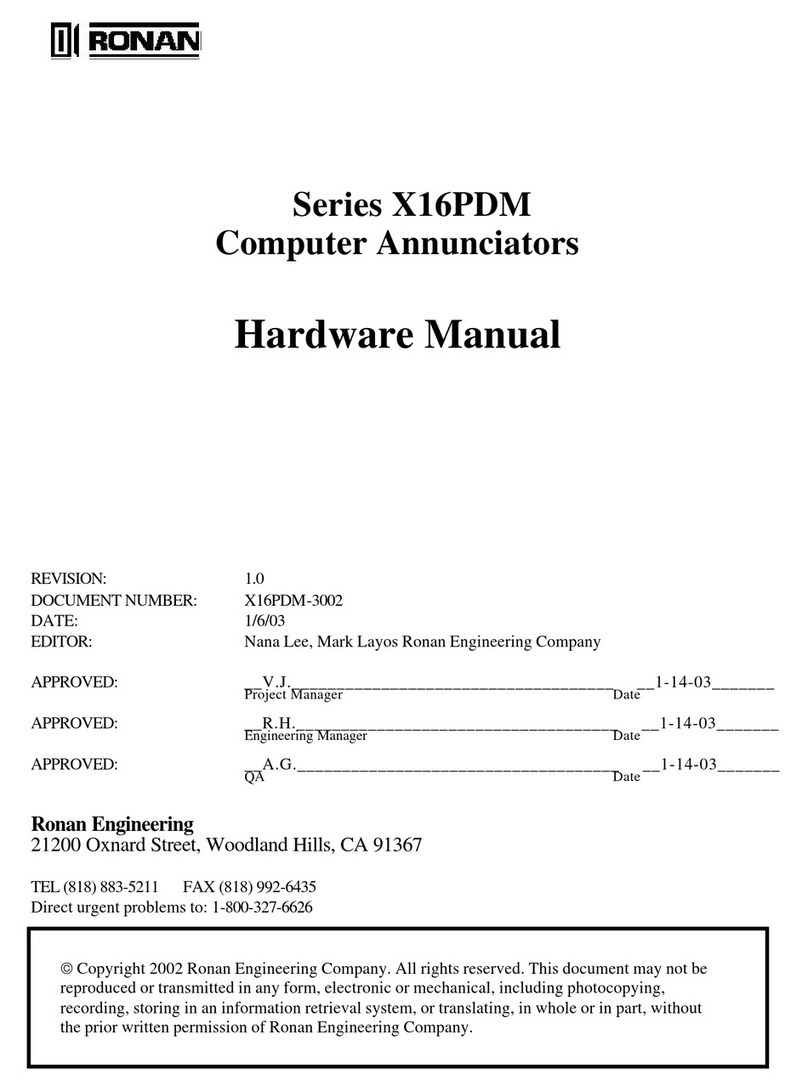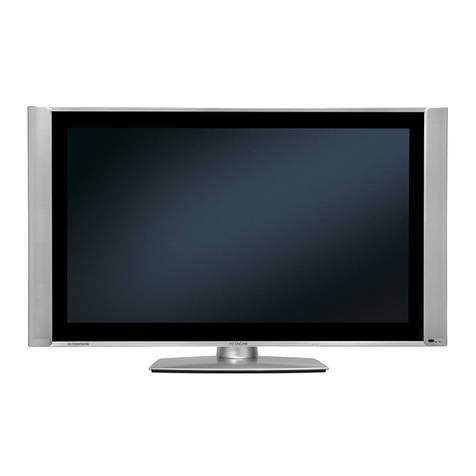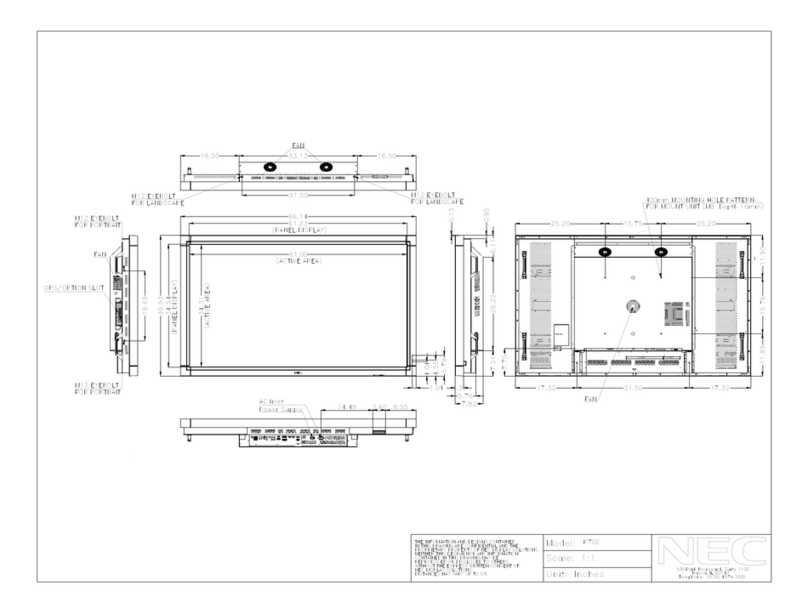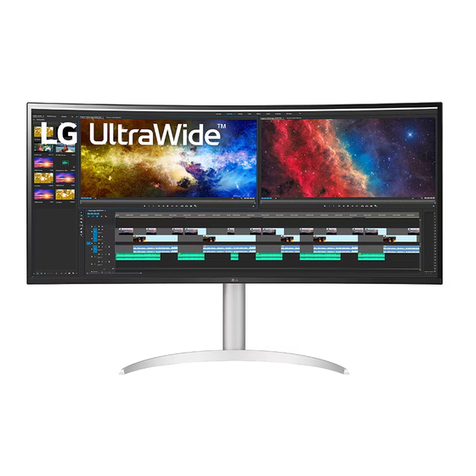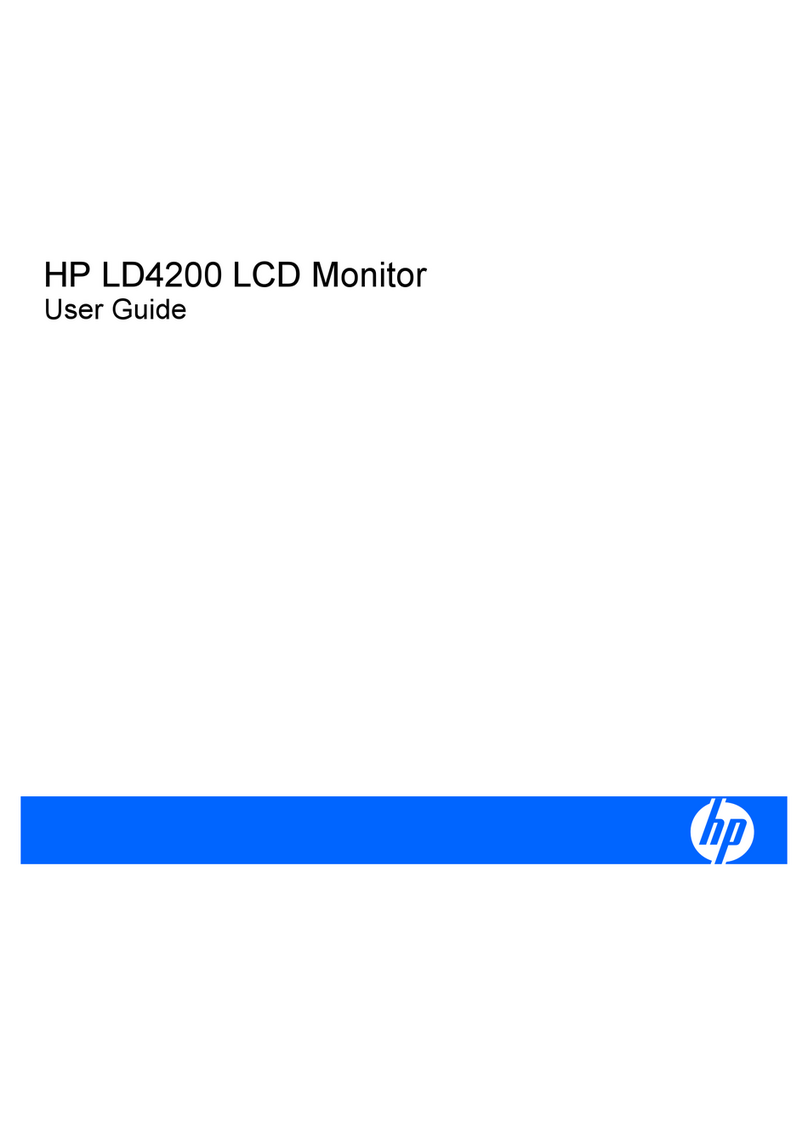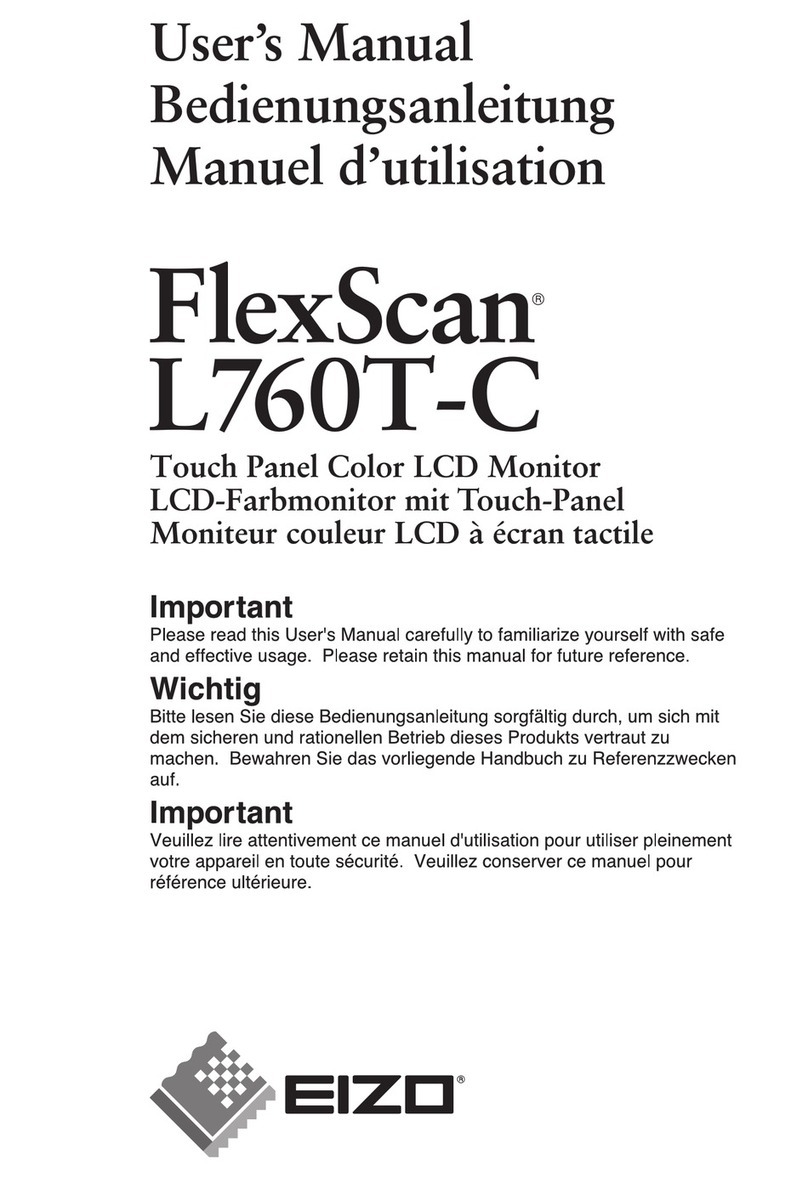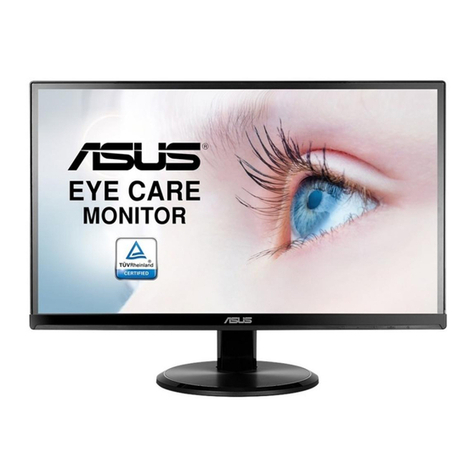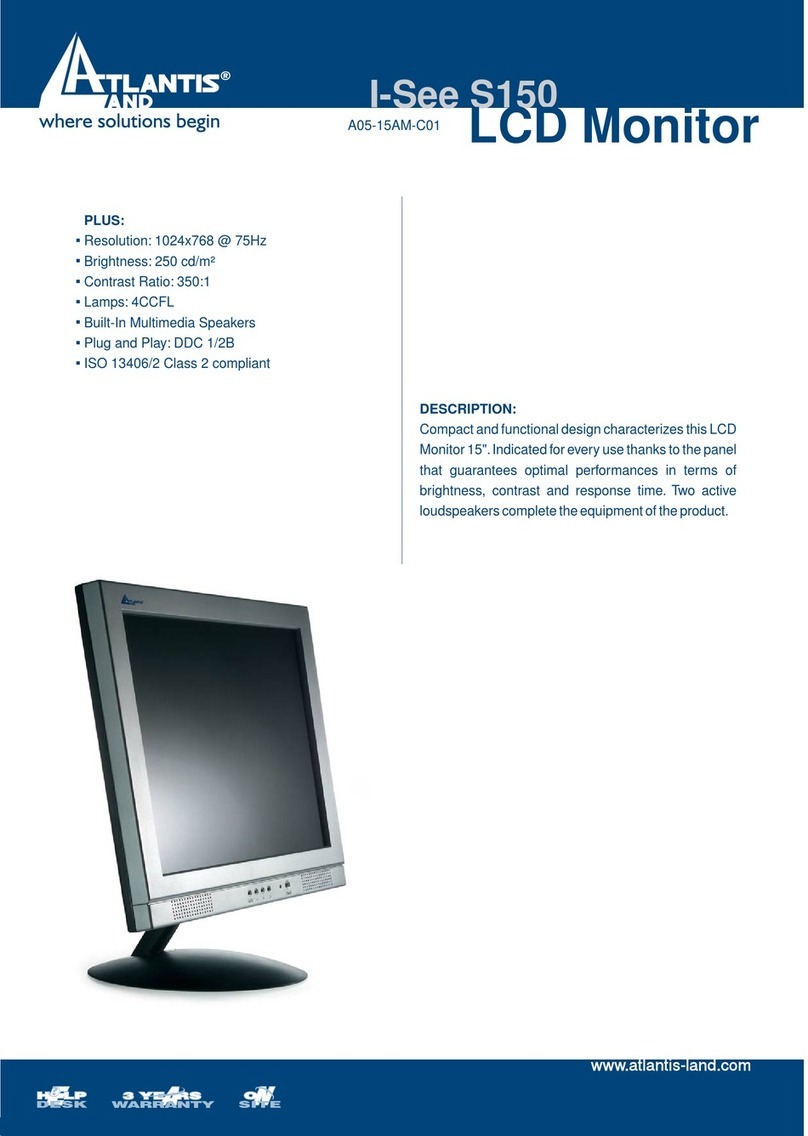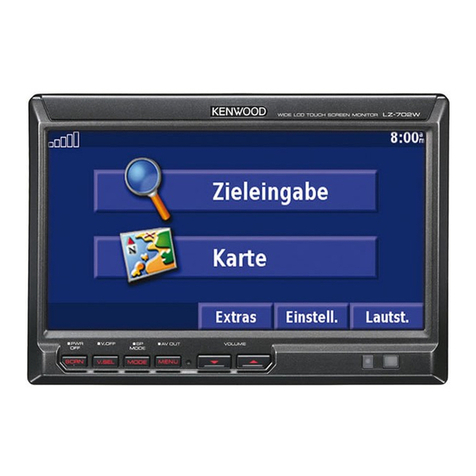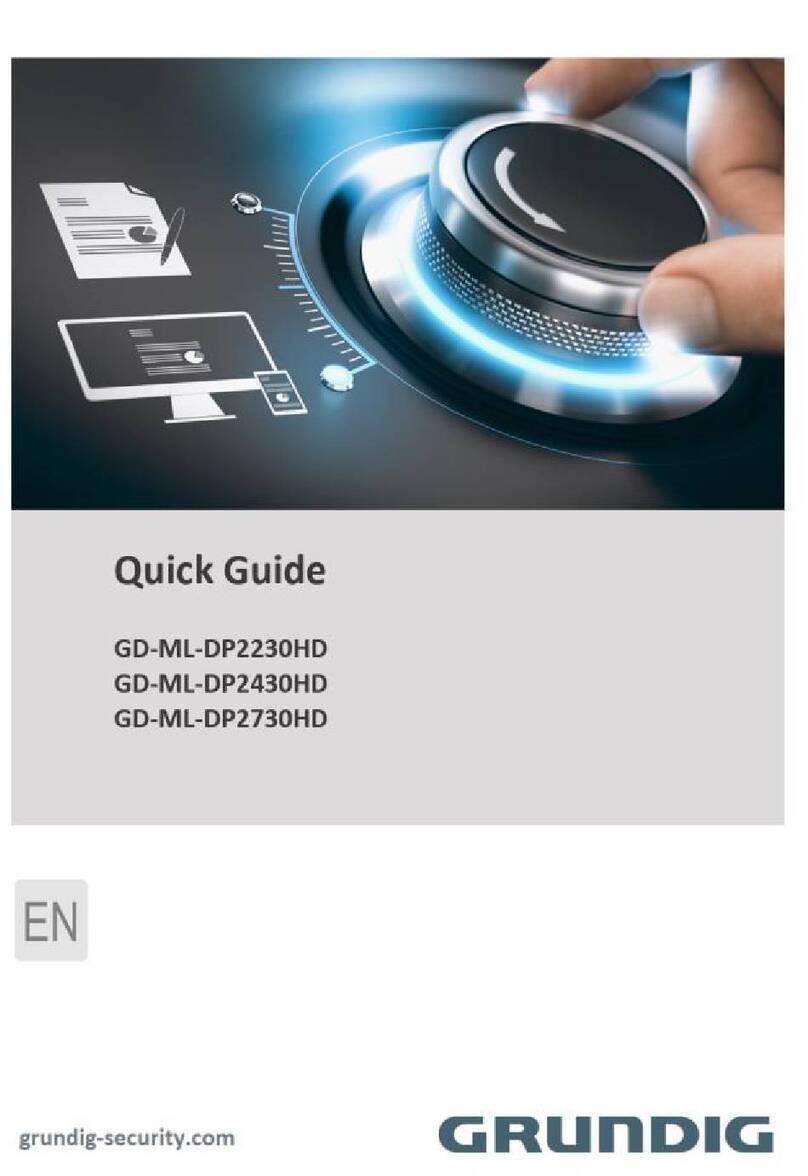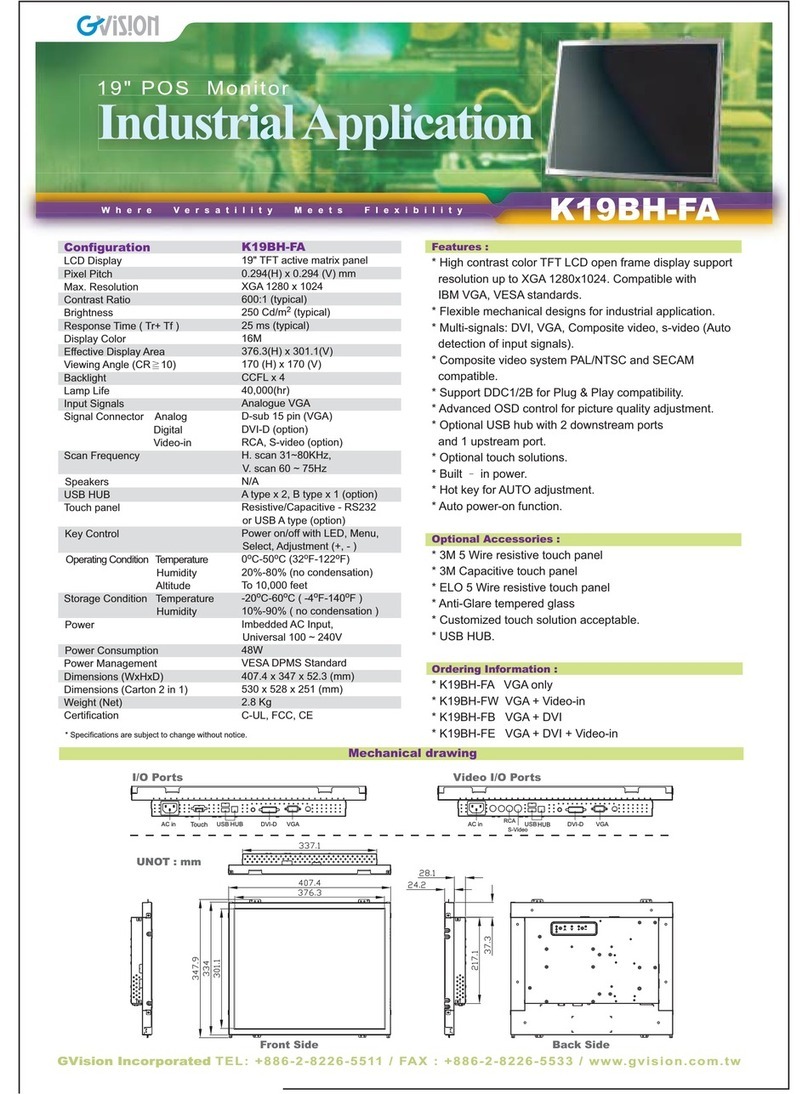ATAGO Twilight AT-CM800a User manual

Refractómetro en línea
AT-CM800a

3564-E03
IN-LINE BRIX‐MONITOR
Instruction Manual
Cat.No..3564


-1-
CONTENTS
1.Precautions for Use······················································································· 2
2.Refractive Index and Brix(%) ··········································································· 8
(
1
)
What is refractometer?···························································································8
(
2
)
What is the Refractive Index?··················································································8
(
3
)
Brix(%) scale ·······································································································8
(
4
)
Temperature correction··························································································8
3.Unpacking and Installation ·············································································· 9
(
1
)
Configuration·······································································································9
(
2
)
Unpacking·········································································································10
(
3
)
Installation·········································································································10
4.Names and Functions of Components ······························································ 11
(
1
)
CM-800
α
··········································································································11
(
2
)
Operation Display·······························································································12
(
3
)
AC Adapter AD-32, AD-33 or AD-34 (Optional)························································· 12
5.Mounting the CM-800
α
andAC adapterAD-32 (AD-33 orAD-34) (Optional)···············13
6.Mounting the Sample Inlet Unit········································································14
(
1
)
Installation of the CM-800
α
with the sample inlet unit (optional): ··································· 14
(
2
)
Installation of the CM-800
α
without the sample inlet unit (optional):·······························16
7.Connecting the Power Cable or AC Adapter AD-32 (AD-33 orAD-34) (Optional) ·········17
(
1
)
When the CM-800
α
is used alone ·········································································· 17
(
2
)
When the AC adapter AD-32, AD-33 or AD-34 (Optional) is used ·································18
8.External Output ···························································································19
(
1
)
Recorder output ·································································································19
(
2
)
RS-232C output ································································································· 20
9.Power Supply······························································································22
(
1
)
When the CM-800
α
is used alone ·········································································· 22
(
2
)
When the AC adapter AD-32, AD-33 or AD-34 (optional) is used··································22
10.Measuring Brix(%)······················································································23
11.Setting the Measurement Interval and Mode-S Level &
Changing the Number of Decimal Places Displayed············································24
(
1
)
Setting the Measurement Interval and Mode-S Level ·················································24
(
2
)
Changing the Number of Decimal Places Displayed···················································24
12.Adjusting to the Reference············································································25
13.Setting theTemperature Correction Values·······················································26
14.Setting the Recorder Output··········································································30
15.Cleaning the Prism ·····················································································32
16.Error Codes & Troubleshooting······································································33
17.Consumable Parts and Optional Items·····························································34
(
1
)
Consumable Parts······························································································ 34
(
2
)
Optional Items····································································································34
18.Relationships between Brix(%) Values and Refractive Index (nD) Values·················35
19.Specifications····························································································36
20.Dimensions·······························································································37
21.Repair Service and Warranty Period ·······························································38
22.ATAGO CO.,LTD. Service Centers··································································39

-2-
1. Precautions for Use
Introduction
Thank you for purchasing the CM-800αIn-line Brix-Monitor.
Before using your CM-800α, rea this instruction manual carefully, an keep it on han for future reference.
For safe use --- Be sure to observe the following.
To prevent injury an amage to property, safely operate the CM-800α by observing the precautions outline in
this manual.
The explanation of the in ications an symbols of the precautions are as follows.
Rea an un erstan them before continuing on to the following pages.
Explanation of in ications
WARNING
If this in ication is neglecte an the instrument is han le incorrectly, serious injury or
eath may result.
CAUTION
If this in ication is neglecte an the instrument is han le incorrectly, injury an /or
property amage may result.
Explanation of symbols
This symbol enotes an item of which to be warne or cautione .
The contents of warning are escribe in etail in or near the △.
This symbol enotes an action that must not be performe (a prohibite item).
The contents of prohibition are escribe in etail in or near the ○.
This symbol enotes an action that must be performe .
The contents of instruction are escribe in etail in or near the ●.

-3-
Handling of this instrument
WARNING
◇When measuring a
substance harmful to the human
body, be aware of its properties and wear protective
gloves, mask, etc.
◇
Immediately turn off the power ( C24V) if the unit
begins to overheat, smoke or emit an abnormal smell.
If the AC adapter A -32, A -33 or A -3
4 (optional)
is used, remove the power cable plug from the AC
100-
240V outlet. Fire or malfunction may result if the
instrument continues to be used. Contact your
ATAGO istributor for an inspection.
◇ o not attempt to repair, modify, or disas
semble the
instrument yourself.
Improper servicing may result in fire, electrical shock,
or burns.
◇
If the instrument is dropped or is subjected to a
strong shock, have it inspected by an Authorized
ATAGO Service Center.
Fire or malfunction may result
if the instrument is
used.
CAUTION
◇
o not apply water or sample to any part of the
instrument other than the surface of the prism.
Applying water to any other part of the instrument
may result in a malfunction.
◇ o not measure very hot or highly acidic samples.
This may damage the prism, which would result in
inaccurate measurements.

-4-
Handling of this instrument (Continued)
CAUTION
◇
DO NOT measure any sample that can damage the
prism or the sample inlet unit.
◇Sample temperature should be kept between 5
and 100 when the power is turned on.
◇Cleaning liquids up to 150
can be used for CIP or
SIP. The cleaning liquid can be used safely for 30
minutes at one time. The momentary difference
between the sample liquid temperature and th
e
cleaning liquid temperature must be no more than
80 .
When using cleaning liquids at temperatures over
150
, the power source (DC24V) must be turned
off. If the AD-32 (AD-33 or AD-
34) is used, unplug
from the outlet before cleaning.
◇The lower limit valu
e of wetted parts temperature is
-30 .
◇
If the sample could possibly stain the prism,
immediately clean the prism according to the
procedure described on page 32 "15.
Cleaning the
Prism".
◇The CM-800α
power (DC24V) should be turned off
when it is not to be used for a long period of time. If
the AD adapter AD-32, AD-33 or AD-
34 (optional) is
used, disconnect the power cable plug from the AC
100-240V outlet.
◇When transporti
ng the instrument, pack it in the
original box.
◇
When transporting by aircraft, disconnect the power
(DC24V) cable or
the DC output cable of the AC
adapter AD-32, AD-33 or AD-
34 (optional) from the
power input terminal of the CM-800α.
◇Carefully read this instruction manual and fully understand the function and operation of each part of the
instrument before use.
◇Check that each part of the instrument operates normally before use.
◇Perform the necessary inspections and reference adjustments according to the instruction manual.
◇The manufacturer shall not be held responsible for any damage that results from using the instrument for other
than its intended purposes (measurement of Brix(%), sugar content, liquid concentration).
◇The manufacturer shall not be held responsible if the use of the instrument has an undesired effect on the
measured materials.
◇The prism in contact with the sample is a consumable item.

-5-
Handling of plug
WARNING
◇Supply the CM-800α with DC24V
only (allowable
fluctuation is
±
0%).
Short-
circuit, smoke, or fire may occur if other
voltages are used.
◇The AC adapter AD-32 (AD-33 or AD-
34) plug must
be inserted into an AC 00-
240V outlet. Other
outlets may result in a short circuit, smoke, or fire.
◇Do not use a power cable and plug
that is damaged,
cut, broken, or altered.
Use may result in fire, electrical shock, or burn.
For repair service of the power cable and plug
,
contact an Authorized ATAGO Service Center.
◇Do not cut a plug to extend t
he power cable of the
AD-32 (AD-33 or AD-34).
CAUTION
◇
Do not insert or pull out the connector and plug with
wet hands.
◇
When disconnecting the power cable of the AC
adapter AD-32, AD-33 or AD-
34 (optional) from the
AC 00-240V outlet, rem
ove by pulling on the plug
only.
Pulling the cable may damage it, and could result in
fire or electrical shock.
◇
Connect the grounding wire when connecting the
plug of the power cable of the AC adapter AD-
32,
AD-33 or AD-34 (optional) to the AC 00-
240V
outlet.

-6-
Connection of optional component (printer, etc.)
WARNING
◇
Turn off the power (DC24V) prior to connecting
cables to the individual units If the AC adapter
AD-32, AD-33 or AD-
34 (optional) is used, pull out
the power cable plug from the AC100-240V outl
et
before connecting
Connecting the cables while the power is on may
result in electrical shock

-7-
Conditions to be observed when using
Environmental conditions
◇Use the instrument at an altitude below 2,000m (above sea level).
◇Use the instrument indoors.
◇Use the instrument where the temperature is between 5 to 40℃.
◇ o not leave the instrument in a location exposed to direct sunlight or near a heating unit where the
temperature may rise.
◇ o not change the environmental temperature of the instrument suddenly.
◇ o not place the instrument in a place where it may be subject to strong vibrations.
◇ o not use the instrument where there is much dust.
◇ o not leave the instrument where the temperature is extremely low.
◇ o not leave the instrument in a damp place.
◇ o not place or drop heavy objects on the instrument.
◇Use this instrument under the condition where humidity is 80% at 31℃ or lower, falling linearly to 50% at 40℃.
◇Main supply voltage fluctuation should not to exceed ±10% the nominal voltage.
◇Installation categories (Overvoltage Categories): ll
◇The pollution degree is 2 (according to IEC60664).
Handling
◇ o not drop the instrument or subject it to any strong shock.
◇The power cable may be damaged by:
●
Bending the cable.
●
Pulling the cable.
●
Twisting the cable.
●
Placing the cable under heavy objects.
●
Catching the cable between objects.
Daily maintenance
◇If the instrument becomes dirty, wipe it with a soft cloth.
◇ o not use benzine, paint thinner, etc. to clean the instrument.

-8-
2. Refractive Index and Brix(%)
The In-line Brix-Monitor CM-800α is a refractometer that detects the Refractive Index of a sample and outputs
the Brix(% value on the display.
The CM-800α can also transmit measured data to external devices via 4 to 20mA or RS-232C.
(
1
)
What is refractometer?
When a straw is placed into a glass filled with water, the straw appears to bend. When a straw is placed into a
glass filled with sugar water, the straw appears to bend much more sharply than in the case of water alone.
This phenomenon is known as the refraction of light. The refractometer is an instrument that measures the
Refractive Index by utilizing this principle (the Refractive Index increases in proportion to the concentration of
the solution , and was developed by Dr. Ernst Abbe at the end of the 19th century.
(
2
)
What is the Refractive Index?
If the Refractive Index of air under atmospheric pressure is 1, then when
light enters medium χ, the ratio of the sine of the incident angle α
measured against the phase boundary to the sine of the refracting angle
β is called the Refractive Index of the mediumχ.
The Refractive Index varies with the wavelength of light and
temperature and is represented as follows:
n
t
D
n : Represents the Refractive Index
t : Temperature (℃
D : D-line of natrium (589nm
For example, Refractive Index of water at 20℃ under the D-line is:
= 1.33299:
(Generally expressed as nD = 1.33299.
m
The Refractive Index is based upon the supposition that the Refractive Index in a vacuum is 1 and is
called the absolute Refractive Index. Generally, however, this index is seldom used.
(
3
)
Brix(%) scale
The CM-800α is programmed with the Brix(% scale, based on the Refractive Index of water (nD = 1.33299
as the reference (0% . The Brix(% scale represents the weight of sucrose expressed by percentage (sucrose
weight in grams contained in 100 grams of sucrose solution .
Therefore, this scale corresponds with the sucrose concentration. However, most samples are comprised of
ingredients other than sugar. The total concentration of these ingredients is represented by the Brix(% , so
this makes the Brix(% scale a practical tool for measuring concentrations.
m
The Brix(% scale is recommended by ICUMSA (International Committee of Uniform Method of Sugar
Analysis and is expressed in % mas (Sucrose in international units (SI unit .
C
The relationship between Brix(% and the Refractive Index (nD is outlined on page 35.
(
4
)
Temperature correction
The Refractive Index of a substance varies with temperature. Thus, when using a refractometer to measure
the Refractive Index of a liquid, the measurement value will vary with the sample temperature.
The CM-800α always detects the prism temperature. The value of the measurement is automatically
corrected for temperature by a built-in processor, so that the displayed value is equal to the value measured
at 20℃ (provided that the sample temperature is within the range of 5 to 100℃ .
Air
Medium χ
n=1
α
β
nχ= sin α
sin β

-9-
3. Unpacking and Installation
(
1
)
Configuration
The CM-800α is comprised of the items listed below.
① Main unit of the In-line Bri -Monitor CM-800α.
② through ⑥ are optional items and are included with the main unit if ordered. Additional items can be
ordered at any time. For details, please contact an Authorized ATAGO Distributor.
① In-line Bri -Monitor CM-800α (Cat.No.3564)
・CM-800α main unit
・Power (DC24V) cable: appro . 1m
・Instruction manual (this book)
・Inspection certificate
②AC adapter AD-32 (Cat.No. 3527), AD-33 (Cat.No. 3528) or AD-34 (Cat.No. 3529)
The AD-32 is an adapter that converts AC 100V to DC24V for supplying power to the CM-800α.
The AD-33 is an adapter that converts AC 110V to DC24V for supplying power to the CM-800α.
The AD-34 is an adapter that converts AC 220-240V to DC24V for supplying power to the CM-800α.
③Sample inlet unit
IDF/ISO clamp union (ferrule), IDF/ISO screw union (screw), JIS Flange, small diameter series compression
fitting and hose connector are available. Refer to page 34 "17. Consumable Parts and Optional Items".
④Recorder output cable
・ 5 meters (Parts No.RE-5635)
・10 meters (Parts No.RE-5636)
・15 meters (Parts No.RE-5638)
・20 meters (Parts No.RE-5639)
⑤RS-232C cable
・15 meters
D-sub 9pin (Parts No. RE-65330) D-sub 25pin (Parts No. RE-5677)
・1 to 15 meters
D-sub 9pin (Parts No. RE-65331) D-sub 25pin (Parts No. RE-5647)
⑥Stand (RE-8607) for mounting the CM-800α main unit and the AD-32 (AD-33 or AD-34)
・Stand
・He agonal-head bolts (M6
×
10)··················8
・Spring washers···················································8
・Washers·································································8

-10-
(
2
)
Unpacking
①Unpack the CM-800α and confirm that there is no external damage.
②Confirm that all parts of the main unit accessories and any optional units as described in section "(1)
Configuration" (
C
page 9) are included.
(
3
)
Installation
CAUTION
◇Before using the recorder output terminal or the RS-232C output terminal
remove the two metallic caps by turning them counterclockwise.
Fig.3-1
①Connect the CM-800α to an AC100-240V main outlet (voltage fluctuations not to exceed 10%) 50/60Hz
with the power cable.
②The CM-800α should be supplied with DC24V (allowable fluctuation is ±10%).
The AC adapter AD-32 AD-33 or AD-34 (optional) should be connected to a power supply of AC
100-240V 50/60 Hz.
③The CM-800α should be installed in a location with an ambient temperature of 5 to 40℃.
④Because the CM-800α incorporates highly precise components DO NOT install in locations exposed to
direct sunlight or near a heating source or in an environment that is dusty or exposed to corrosive gasses.
⑤The CM-800α should be installed in a location that is free from vibration. When installing take special care
to avoid any strong shock to the instrument.

-11-
4. Names and Functions of Components
(
1
)
CM-800
α
①Prism
Corrosion resistant optical glass, with a polished
surface to reflect light.
②Prism stage
Connected to the sample inlet and fastened by a
clamp band.
③Radiator
isperses heat when measuring high temperature
samples to prevent the electric circuit from
overheating.
④Mounting screw locations
Used to mount the CM-800α to the stand.
⑤Operation display
Comprised of the operation keys and display
C
"(2)Operation isplay" page 12
⑥Power ( C24V) input terminal
Terminal to connect the power cable (for C24V
input) or the C output cable of the AC adapter
A -32, A -33 or A -34 (optional)
⑦RS-232C output terminal
Terminal to connect to a computer.
⑧Recorder output terminal
Terminal to connect to a recorder.
③
④
⑥
⑦
⑧
Fig.4-2
①
②
Fig.4-1
⑤
④

-12-
(
2
)
Operation Display
①Measurement value display
Digitally displays the measurement value [Brix(%)],
setting m de, and ther setting values.
② key
Switches r sets the display m de f the
measurement value and the setting m de.
Setting mode
number Setting description
[0]
Measurement Interval and M de-S Level
[1]
Adjustment t the reference
[2]
Temperature c rrecti n fact r
[3]
Rec rder utput, l wer limit value
[4]
Rec rder utput, upper limit value
[5]
Changing the Number f Decimal Places
Displayed
③Up and d wn keys
Increase r decrease the value in each setting m de.
The d wn key als switches the display f each
setting m de.
The temperature is displayed when press the d wn
key while measuring a sample.
(
3
)
ACAdapterAD-32,AD-33 orAD-34 (Optional)
①P wer cable
C nnects t the AC 100-240V utlet.
②DC utput cable
C nnects t the utput DC24V.
③Pil t lamp
Functi ns when AC 100-240V is being input and
DC24V is being utput.
④M unting screw h les
These h les are used t m unt the AD-32, AD-33 r
AD-34 t the stand.
①
Fig.4-3
② ③
③
①
②
Fig.4-4
④
Fig.4-5

-13-
5. Mounting the CM-800
α
and AC adapterAD-32 (AD-33 or
AD-34) (Optional)
WARNING
◇Turn off the power (DC24V) before mounting. If AD-32 (AD-33 or AD-34) is use ,
isconnect the power cable's plug from the AC 100-240V outlet before beginning.
Electrical shock may occur if the unit is mounte with the power connecte .
①Mounting screws (Fig.5-1,Fig.5-2)
The CM-800α an the AD-32 (AD-33 or AD-34)
each have four mounting screw locations.
Use the screws supplie with the stan to mount the
CM-800α an AD-32 (AD-33 or AD-34) on the
stan or panel plate.
The epth of the screw locations is 10mm, M6.
Example of screw configuration (Fig.5-3)
①CM-800α or AD-32 (AD-33 or AD-34)
②Washer (M6)
③Spring washer (M6)
④Hexagonal-hea bolt M6×10
m
Hexagonal-hea bolts, spring washers an
washers are inclu e as stan ar accessories
with the stan (optional).
N
Length of the hexagonal-hea bolt =
(Screw hole epth, 10mm) + (Panel plate length)
Mounting on a stan (optional) (Fig.5-4)
C
For information on or ering a stan , see page 34.
③
①
②
CM-800α
Fig.5-1
④
AD-32, AD-33 or AD-34
Fig.5-2
Fig.5-4
Fig.5-3
①
①
148mm
98mm
148mm
98mm

-14-
6. Mounting the Sample Inlet Unit
WARNING
◇Turn off the power (DC24V) before mounting. If AD-32 (AD-33 or AD-34) is use ,
isconnect the power cable's plug from the AC 100-240V outlet before beginning.
Electrical shock may occur if the unit is mounte with the power connecte .
CAUTION
◇Ensure that the prism is clean an free of any amage an /or scratches.
Completely remove any sample before installing the CM-800α to piping or
equipment
(
1
)
Installation of the CM-800
α
with the sample inlet unit (optional):
Compression Fitting Hose connector
Straight type L type
Fig.6-1

-15-
Mounting procedure
①Install the CM-800α so that the prism surface is
at a right angle to the ground.
②Attach the sample inlet unit to the CM-800α ith
O-ring (accessory) inserted bet een them, and
fasten them together ith the clamp band
(accessory).
③Install the inlet unit so that the sample solution
runs from the lo er nozzle to the upper nozzle to
prevent air bubbles from forming.
④When connecting the tubes to the hose connector,
clamp them ith a tie band.
C
"Use of tie bands" page 16
⑤The prism surface may become contaminated ith
solids, dirt and/or grease. If this happens, the prism
surface must be cleaned by hand.
C
"15. Cleaning the Prism" page 32
The sample inlet unit should be installed in such a
manner that it can be easily removed to allo
access to the prism for cleaning.
N
Suspending the CM-800α (2.3kg) hen using
the sample inlet unit to connect to the piping
is dangerous.
Use of the optional stand is recommended.
C
"5. Mounting the CM-800
α
and AC
adapter AD-32 (AD-33 or AD-34) (Optional)"
page 13
C
"17. Consumable Parts and Optional
Items" page 34
Fig.6-2
Fig.6-3
Fig.6-4
Top
Prism stage
O-ring
Sample inlet unit
(optional)
Clamp band
Bottom Prism stage
Flo of solution
Flo of
solution
O-ring

-16-
●Use of tie bands (Hose connector (RE-67501) only)
The hose connector (RE-67501) comes with tie bands as shown in Fig.6-5.
①Insert an end o tube onto the nozzle so that the tube is
tightly put on the nozzle.
②To asten the tube with the tie band, insert the tip o the
tie band into the slot (Fig.6-6).
③While holding the tie band by the part A, pull the tip (B) o
the tie band to tighten it (Fig.6-7).
④A ter tightning the tie band, cut the tie band by the part C
or cutting o the extra (Fig.6-8).
m
The tie band that were tightened once cannnot be
reused.
For removing the tie band rom the tube, cut it.
For astening the tube with a tie band again, use a
new tie band.
m
The tie bands are made o plastic. I measuring
chemicals that are corrosive to plastic, use tie bands
made o an alternative material.
N
Tie bands can be ordered through your ATAGO
Distributor.
C
"17. Consumable Parts and Optional Items"
page 34
(
2
)
Installation of the CM-800
α
without the sample
inlet unit (optional):
Please note the ollowing when installing the CM-800α to
piping or equipment without using a sample inlet unit
(optional):
①The size o the prism stage o the CM-800α is a 3S
errule. The errule connection is recommended or
installation.
②Install the CM-800α so that the prism sur ace is at a right
angle to the ground.
③Connect the unit to the piping so that the sample low
directly contacts the prism sur ace. The direct low o
samples (and sel cleaning solutions) in contact with the
prism will keep substances rom adhering to the prism
sur ace.
④When installation to a solution tank is pre erred, allow the
sample low to directly contact the prism sur ace.
⑤The sample solution must remain in the temperature range
o 5 to 100℃.
⑥During operation, build up o solids, dirt and/or grease may
orm on the prism sur ace. When this occurs, the prism
sur ace must be manually cleaned (
C
"15. Cleaning the
Prism" page 32).
For ease o cleaning, the CM-800α should be installed in
such a manner so that the unit can be easily removed rom
the piping or solution tank.
Fig.6-5
Fig.6-6
Fig.6-7
Fig.6-8
A
B
C

-17-
7. Connecting the Power Cable or AC AdapterAD-32 (AD-33 or
AD-34) (Optional)
WARNING
◇Turn off the power (DC24V) when connecting or disconnecting the power cable
(for DC24V) or the DC output cable of the D-32 ( D-33 or D-34) to or from
the terminal. When D-32 ( D-33 or D-34) is used, remove the power cable
plug from the C 100-240V outlet.
CAUTION
◇Disconnect the power cable or the DC output cable of the D-32 ( D-33 or
D-34) from the power input terminal of the CM-800α when transporting the
CM-800α by aircraft.
(
1
)
When the CM-800
α
is used alone
① Connect the power (DC24V) input cable connector
(provided) to the power (DC24V) input terminal located at
the bottom of the CM-800α.
Connect the opening of the input terminal with the
connector pin and insert the connector. Then fasten the
connector by turning the connector ring clockwise. To
disconnect the power cable, fully turn the connector ring
counterclockwise and remove the connector.
②Connect the power (DC24V) input cable terminal to the
power supply of DC24V as illustrated in Fig.7-1.
m
t this stage, keep the DC24V power off.
Power (DC24V) input cable and code information table.
Pin No. Code color
3
Brown +24V
4
Blue GND
Fig.7-2
Approx.2cm
W
aterproof connector plug
Approx.1m Approx.5cm
Clamp filter
Corner tip open terminal
1
2
4
3
Fig.7-1
o input DC24V
Power (DC24V) input cable
Table of contents
Other ATAGO Monitor manuals
